CABG vs PTCA Drug-Eluting Stents: A Review of LMCAD Treatment Efficacy
VerifiedAdded on 2023/06/07
|45
|13958
|85
Literature Review
AI Summary
This literature review compares the effectiveness of Coronary Artery Bypass Grafting (CABG) and Percutaneous Transluminal Angioplasty (PTCA) with drug-eluting stents for the treatment of Left Main Coronary Artery Disease (LMCAD). It investigates the causes, symptoms, and treatment options for LMCAD, highlighting the surgical procedure of CABG and the stent implantation method of PTCA. The review analyzes randomized controlled trials and observational studies to assess the efficacy and safety of both treatments, focusing on outcomes such as myocardial infarction, stroke, death rates, and revascularization needs. The findings suggest that while CABG may be safer for long-term follow-up, both methods have their limitations and potential risks. The review concludes by discussing the implications for future research and the importance of understanding the comparative effectiveness of these treatments for LMCAD.
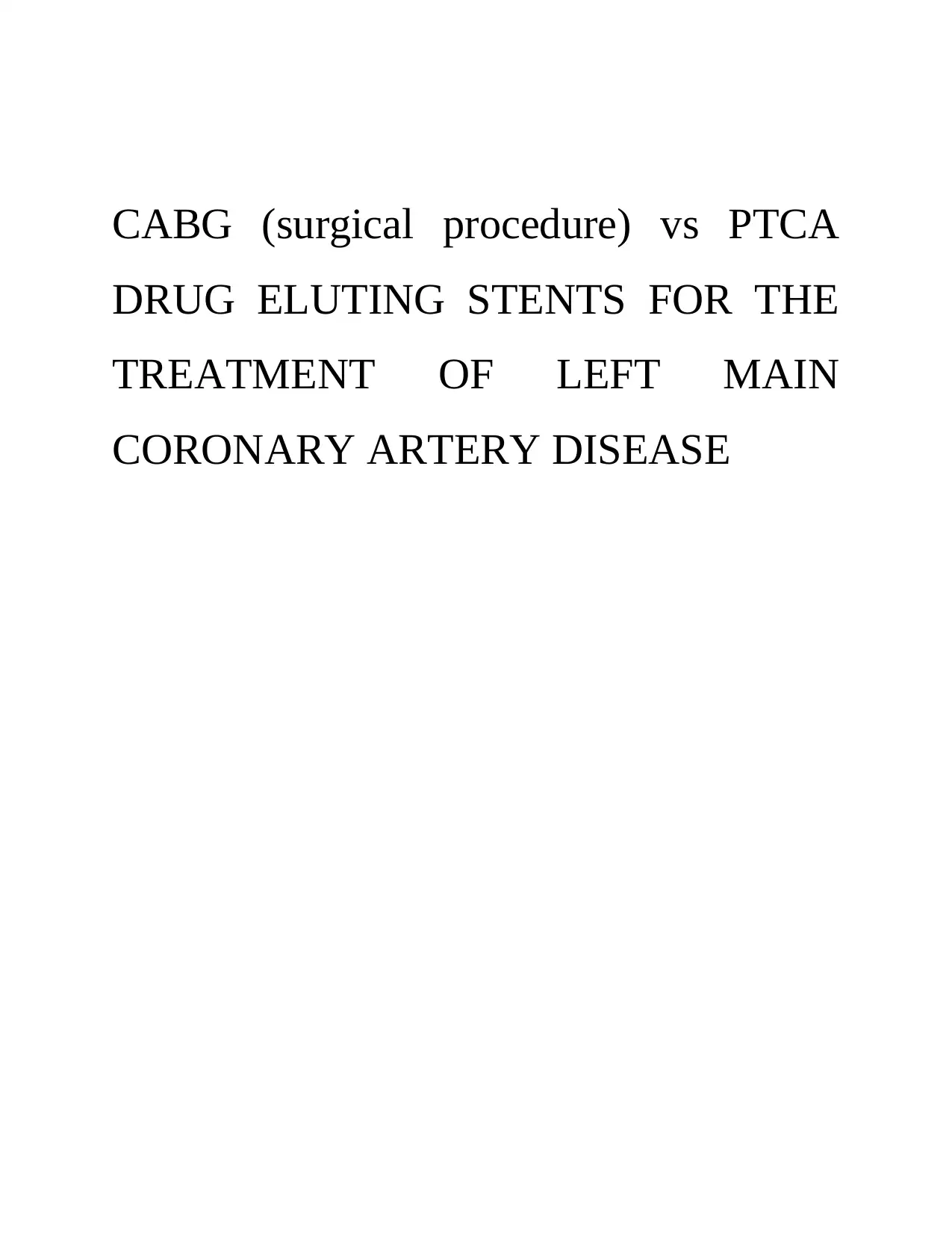
CABG (surgical procedure) vs PTCA
DRUG ELUTING STENTS FOR THE
TREATMENT OF LEFT MAIN
CORONARY ARTERY DISEASE
DRUG ELUTING STENTS FOR THE
TREATMENT OF LEFT MAIN
CORONARY ARTERY DISEASE
Paraphrase This Document
Need a fresh take? Get an instant paraphrase of this document with our AI Paraphraser

Table of Contents
LIST OF FIGURE AND TABLES..................................................................................................1
LIST OF ABBREVIATIONS..........................................................................................................2
ACKNOWLEDGEMENT...............................................................................................................3
ABSTRACT.....................................................................................................................................4
Background.............................................................................................................................4
Methods..................................................................................................................................4
Results....................................................................................................................................4
Conclusion..............................................................................................................................4
TITLE..............................................................................................................................................5
INTRODUCTION...........................................................................................................................5
What is left main coronary artery disease?.............................................................................5
Why left main coronary artery disease is researched?...........................................................5
Causes of left main coronary artery disease...........................................................................6
CABG for the treatment of left main coronary artery disease................................................7
PTCA drug eluting stents for treatment of left main coronary artery disease........................7
Aim.........................................................................................................................................7
Objective.................................................................................................................................8
Research questions.................................................................................................................8
Alternative hypothesis............................................................................................................8
Null hypothesis.......................................................................................................................8
METHODOLOGY..........................................................................................................................9
Criteria for eligibility..............................................................................................................9
Screening of studies..............................................................................................................13
Quality assessment along with data extraction.....................................................................14
Heterogeneity.......................................................................................................................17
Statistics................................................................................................................................17
RESULTS......................................................................................................................................20
PRISMA flowchart...............................................................................................................20
Quality assessment...............................................................................................................22
LIST OF FIGURE AND TABLES..................................................................................................1
LIST OF ABBREVIATIONS..........................................................................................................2
ACKNOWLEDGEMENT...............................................................................................................3
ABSTRACT.....................................................................................................................................4
Background.............................................................................................................................4
Methods..................................................................................................................................4
Results....................................................................................................................................4
Conclusion..............................................................................................................................4
TITLE..............................................................................................................................................5
INTRODUCTION...........................................................................................................................5
What is left main coronary artery disease?.............................................................................5
Why left main coronary artery disease is researched?...........................................................5
Causes of left main coronary artery disease...........................................................................6
CABG for the treatment of left main coronary artery disease................................................7
PTCA drug eluting stents for treatment of left main coronary artery disease........................7
Aim.........................................................................................................................................7
Objective.................................................................................................................................8
Research questions.................................................................................................................8
Alternative hypothesis............................................................................................................8
Null hypothesis.......................................................................................................................8
METHODOLOGY..........................................................................................................................9
Criteria for eligibility..............................................................................................................9
Screening of studies..............................................................................................................13
Quality assessment along with data extraction.....................................................................14
Heterogeneity.......................................................................................................................17
Statistics................................................................................................................................17
RESULTS......................................................................................................................................20
PRISMA flowchart...............................................................................................................20
Quality assessment...............................................................................................................22
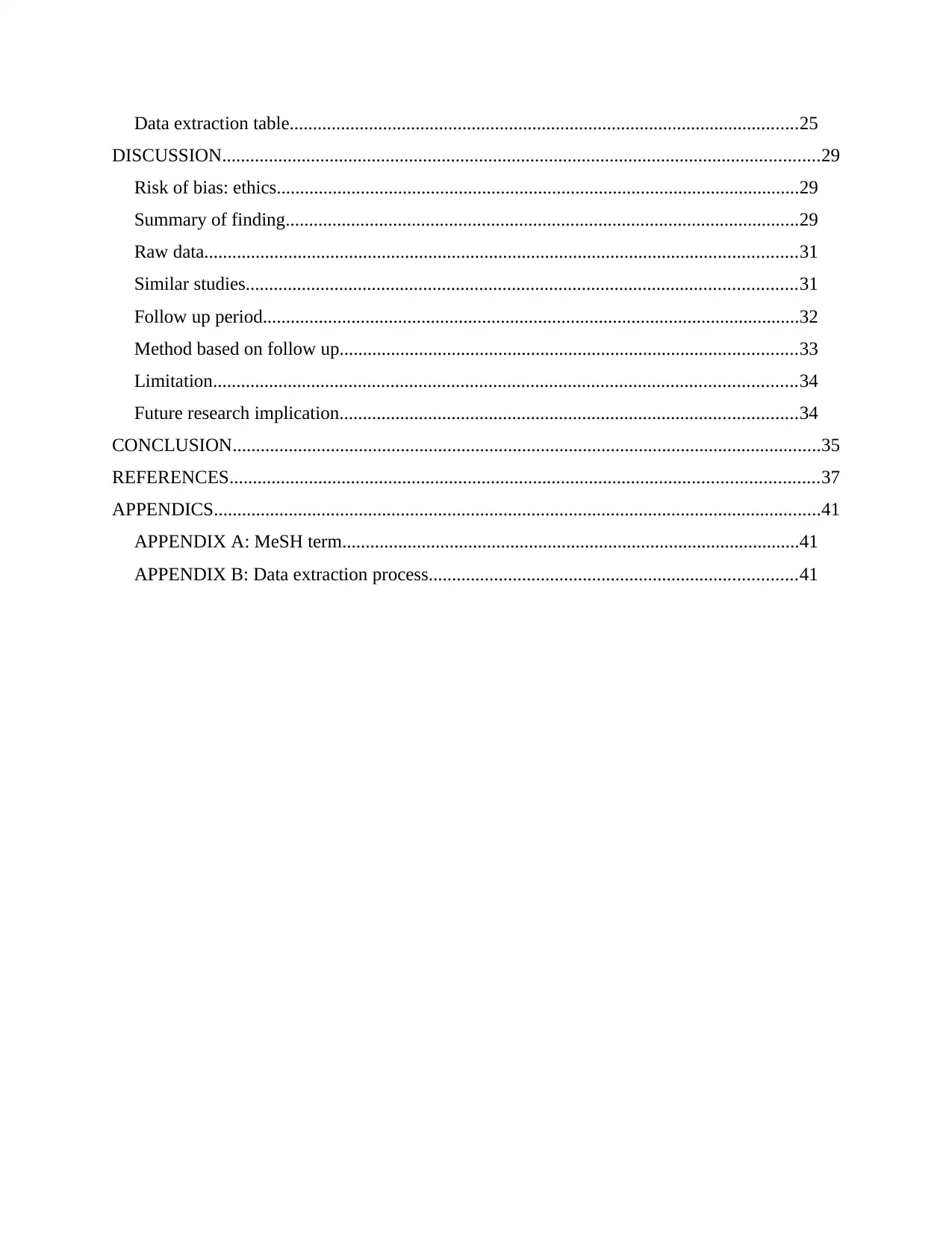
Data extraction table.............................................................................................................25
DISCUSSION................................................................................................................................29
Risk of bias: ethics................................................................................................................29
Summary of finding..............................................................................................................29
Raw data...............................................................................................................................31
Similar studies......................................................................................................................31
Follow up period...................................................................................................................32
Method based on follow up..................................................................................................33
Limitation.............................................................................................................................34
Future research implication..................................................................................................34
CONCLUSION..............................................................................................................................35
REFERENCES..............................................................................................................................37
APPENDICS..................................................................................................................................41
APPENDIX A: MeSH term..................................................................................................41
APPENDIX B: Data extraction process...............................................................................41
DISCUSSION................................................................................................................................29
Risk of bias: ethics................................................................................................................29
Summary of finding..............................................................................................................29
Raw data...............................................................................................................................31
Similar studies......................................................................................................................31
Follow up period...................................................................................................................32
Method based on follow up..................................................................................................33
Limitation.............................................................................................................................34
Future research implication..................................................................................................34
CONCLUSION..............................................................................................................................35
REFERENCES..............................................................................................................................37
APPENDICS..................................................................................................................................41
APPENDIX A: MeSH term..................................................................................................41
APPENDIX B: Data extraction process...............................................................................41
⊘ This is a preview!⊘
Do you want full access?
Subscribe today to unlock all pages.

Trusted by 1+ million students worldwide

LIST OF FIGURE AND TABLES
Table 1 Eligibility criteria
Table 2 PICO search term which are used to search on
PubMed, EMBASE along with Cochran.
Table 3 Inclusion along with exclusion key terms
which are associated with Covidence
Table 4 Data extraction process of included studies
Table 5 Analysis and comparison between CABG and
PTCA drug eluting method used in treatment
of left main coronary artery disease in given
studies
Table 6 Data extraction table
Figure 1 CABG versus PTCA.
Chart 1 PRISMA flowchart
Chart 2 CABG VS PTCA
1
Table 1 Eligibility criteria
Table 2 PICO search term which are used to search on
PubMed, EMBASE along with Cochran.
Table 3 Inclusion along with exclusion key terms
which are associated with Covidence
Table 4 Data extraction process of included studies
Table 5 Analysis and comparison between CABG and
PTCA drug eluting method used in treatment
of left main coronary artery disease in given
studies
Table 6 Data extraction table
Figure 1 CABG versus PTCA.
Chart 1 PRISMA flowchart
Chart 2 CABG VS PTCA
1
Paraphrase This Document
Need a fresh take? Get an instant paraphrase of this document with our AI Paraphraser
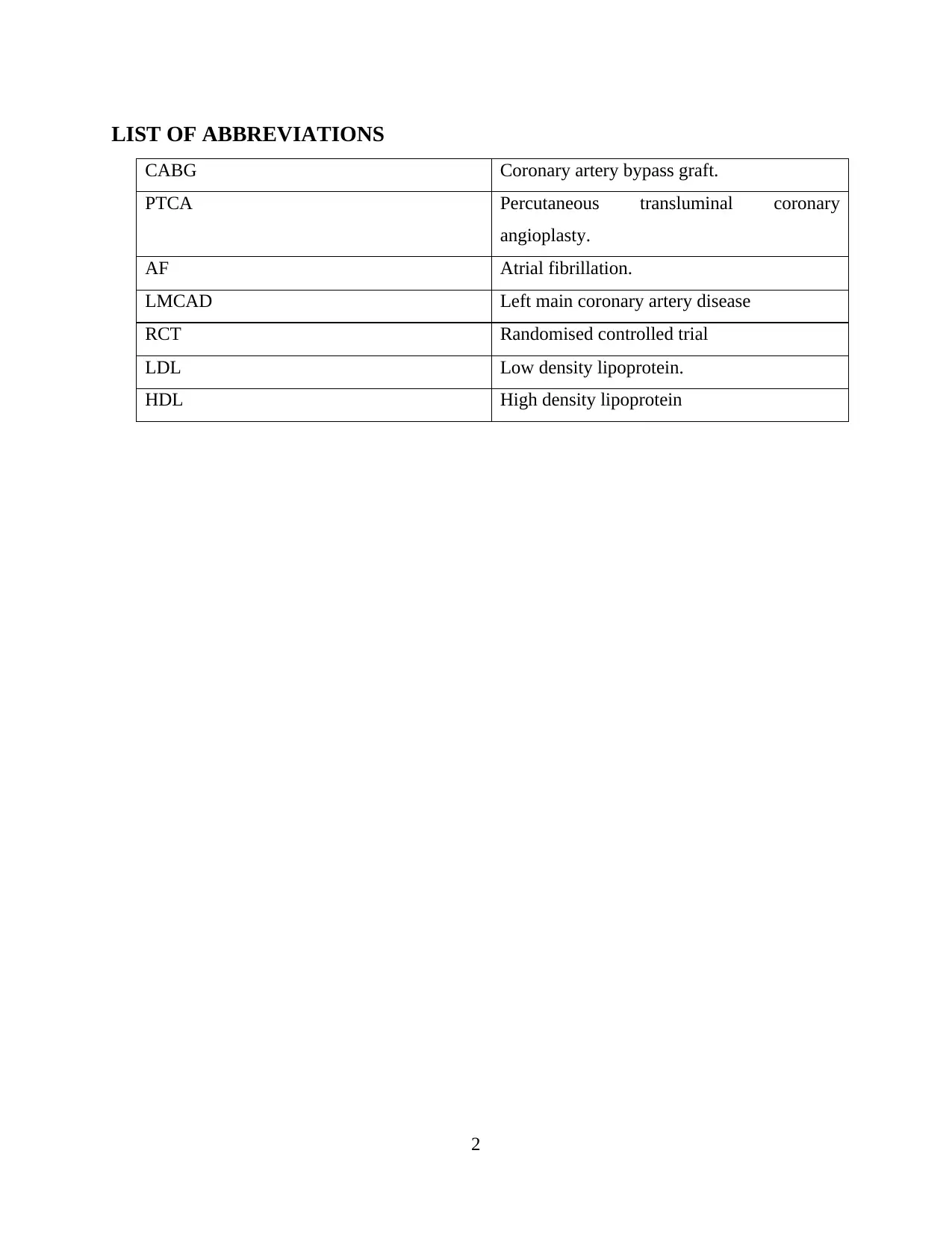
LIST OF ABBREVIATIONS
CABG Coronary artery bypass graft.
PTCA Percutaneous transluminal coronary
angioplasty.
AF Atrial fibrillation.
LMCAD Left main coronary artery disease
RCT Randomised controlled trial
LDL Low density lipoprotein.
HDL High density lipoprotein
2
CABG Coronary artery bypass graft.
PTCA Percutaneous transluminal coronary
angioplasty.
AF Atrial fibrillation.
LMCAD Left main coronary artery disease
RCT Randomised controlled trial
LDL Low density lipoprotein.
HDL High density lipoprotein
2

ACKNOWLEDGEMENT
I would like to express my special thank of gratitude to my teacher………. who gave may a
golden opportunity to do such wonderful project that support my academic journey. The project
is comparative study between CABG and PTCA drug eluting stent in term of effectiveness
for treatment of left main coronary artery disease. I came to know about new thing I really
thankful to them. Apart for this, I would also like to thank my parents and friends who help me to
finalise the project within the limited and proper timeline or timeframe.
3
I would like to express my special thank of gratitude to my teacher………. who gave may a
golden opportunity to do such wonderful project that support my academic journey. The project
is comparative study between CABG and PTCA drug eluting stent in term of effectiveness
for treatment of left main coronary artery disease. I came to know about new thing I really
thankful to them. Apart for this, I would also like to thank my parents and friends who help me to
finalise the project within the limited and proper timeline or timeframe.
3
⊘ This is a preview!⊘
Do you want full access?
Subscribe today to unlock all pages.

Trusted by 1+ million students worldwide
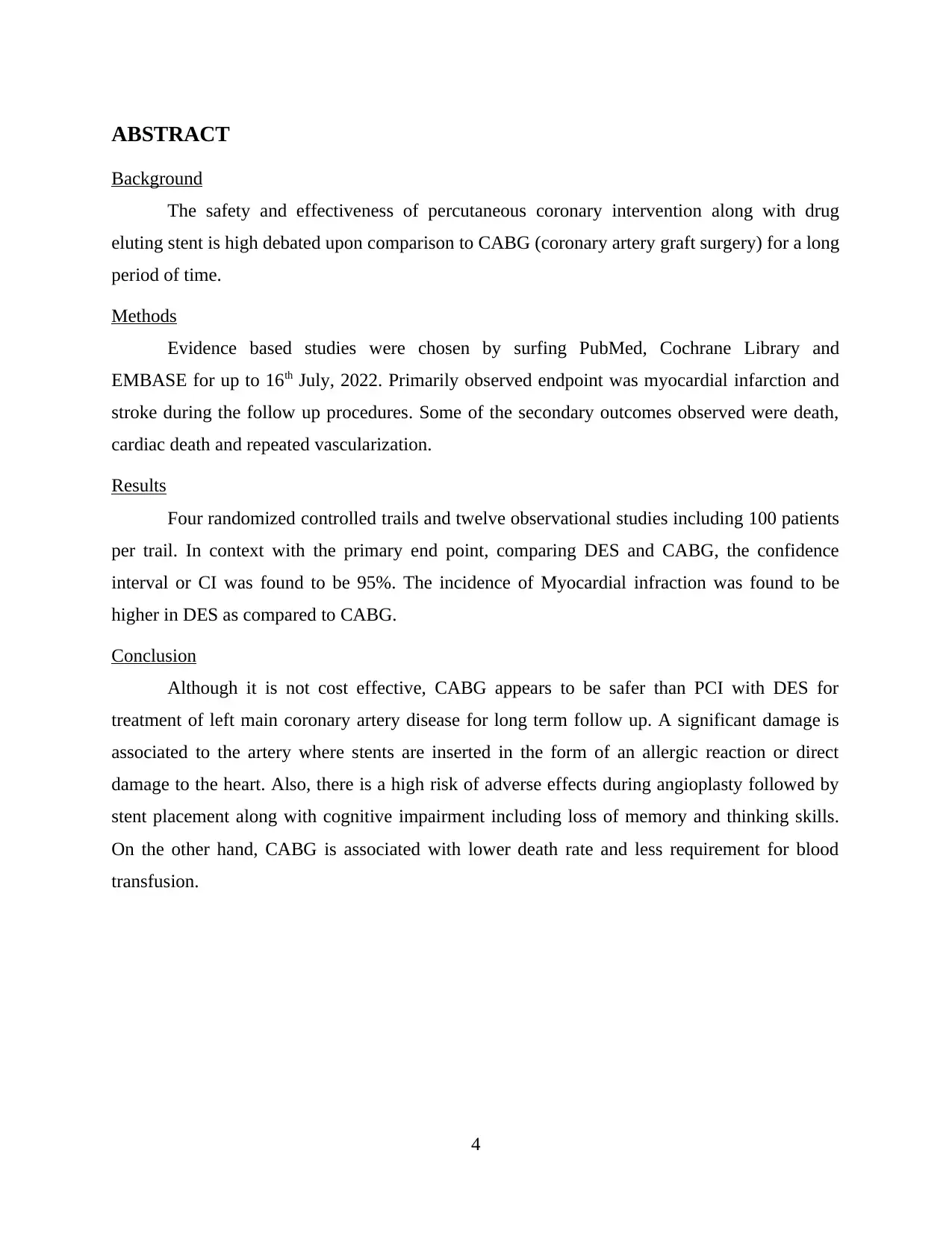
ABSTRACT
Background
The safety and effectiveness of percutaneous coronary intervention along with drug
eluting stent is high debated upon comparison to CABG (coronary artery graft surgery) for a long
period of time.
Methods
Evidence based studies were chosen by surfing PubMed, Cochrane Library and
EMBASE for up to 16th July, 2022. Primarily observed endpoint was myocardial infarction and
stroke during the follow up procedures. Some of the secondary outcomes observed were death,
cardiac death and repeated vascularization.
Results
Four randomized controlled trails and twelve observational studies including 100 patients
per trail. In context with the primary end point, comparing DES and CABG, the confidence
interval or CI was found to be 95%. The incidence of Myocardial infraction was found to be
higher in DES as compared to CABG.
Conclusion
Although it is not cost effective, CABG appears to be safer than PCI with DES for
treatment of left main coronary artery disease for long term follow up. A significant damage is
associated to the artery where stents are inserted in the form of an allergic reaction or direct
damage to the heart. Also, there is a high risk of adverse effects during angioplasty followed by
stent placement along with cognitive impairment including loss of memory and thinking skills.
On the other hand, CABG is associated with lower death rate and less requirement for blood
transfusion.
4
Background
The safety and effectiveness of percutaneous coronary intervention along with drug
eluting stent is high debated upon comparison to CABG (coronary artery graft surgery) for a long
period of time.
Methods
Evidence based studies were chosen by surfing PubMed, Cochrane Library and
EMBASE for up to 16th July, 2022. Primarily observed endpoint was myocardial infarction and
stroke during the follow up procedures. Some of the secondary outcomes observed were death,
cardiac death and repeated vascularization.
Results
Four randomized controlled trails and twelve observational studies including 100 patients
per trail. In context with the primary end point, comparing DES and CABG, the confidence
interval or CI was found to be 95%. The incidence of Myocardial infraction was found to be
higher in DES as compared to CABG.
Conclusion
Although it is not cost effective, CABG appears to be safer than PCI with DES for
treatment of left main coronary artery disease for long term follow up. A significant damage is
associated to the artery where stents are inserted in the form of an allergic reaction or direct
damage to the heart. Also, there is a high risk of adverse effects during angioplasty followed by
stent placement along with cognitive impairment including loss of memory and thinking skills.
On the other hand, CABG is associated with lower death rate and less requirement for blood
transfusion.
4
Paraphrase This Document
Need a fresh take? Get an instant paraphrase of this document with our AI Paraphraser
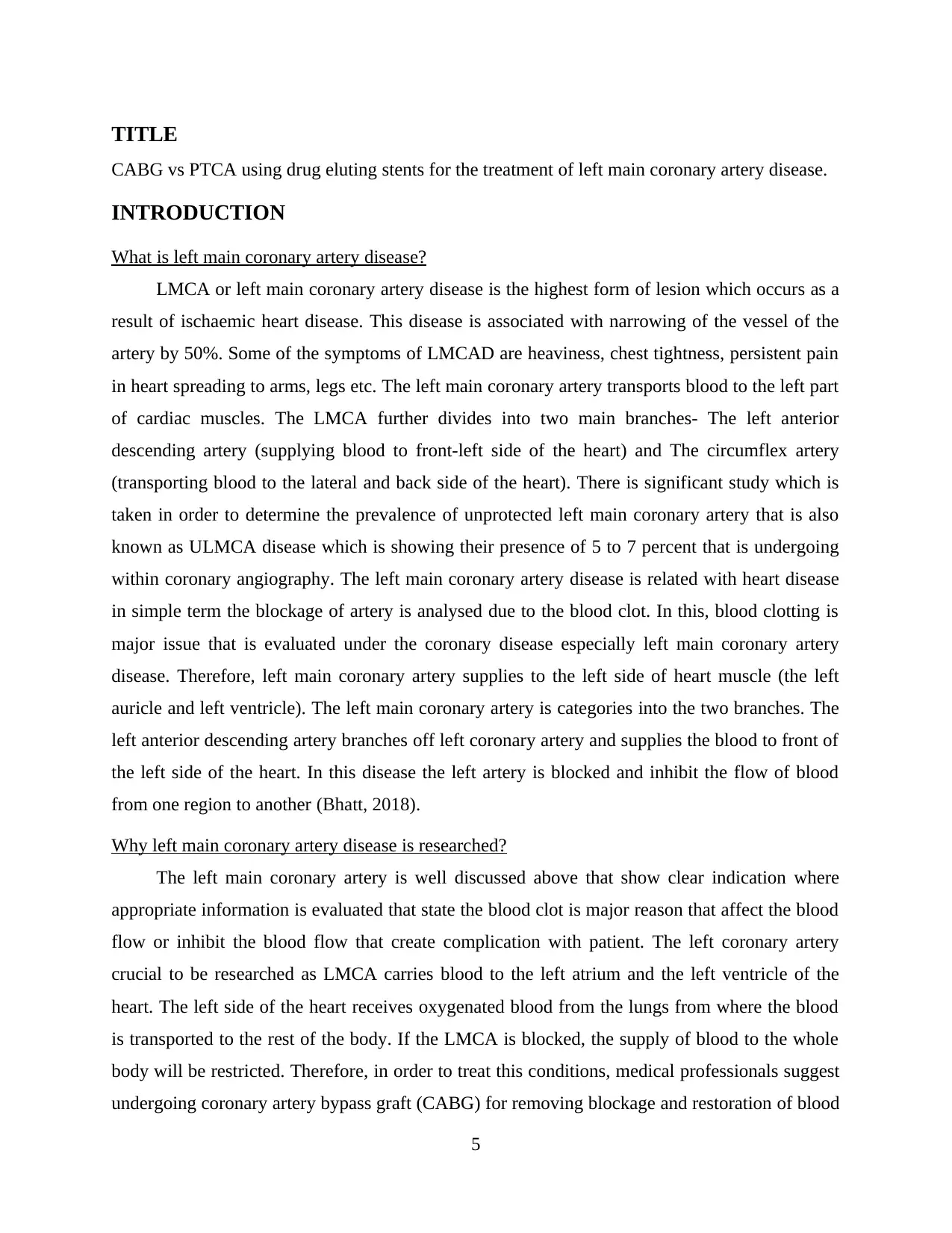
TITLE
CABG vs PTCA using drug eluting stents for the treatment of left main coronary artery disease.
INTRODUCTION
What is left main coronary artery disease?
LMCA or left main coronary artery disease is the highest form of lesion which occurs as a
result of ischaemic heart disease. This disease is associated with narrowing of the vessel of the
artery by 50%. Some of the symptoms of LMCAD are heaviness, chest tightness, persistent pain
in heart spreading to arms, legs etc. The left main coronary artery transports blood to the left part
of cardiac muscles. The LMCA further divides into two main branches- The left anterior
descending artery (supplying blood to front-left side of the heart) and The circumflex artery
(transporting blood to the lateral and back side of the heart). There is significant study which is
taken in order to determine the prevalence of unprotected left main coronary artery that is also
known as ULMCA disease which is showing their presence of 5 to 7 percent that is undergoing
within coronary angiography. The left main coronary artery disease is related with heart disease
in simple term the blockage of artery is analysed due to the blood clot. In this, blood clotting is
major issue that is evaluated under the coronary disease especially left main coronary artery
disease. Therefore, left main coronary artery supplies to the left side of heart muscle (the left
auricle and left ventricle). The left main coronary artery is categories into the two branches. The
left anterior descending artery branches off left coronary artery and supplies the blood to front of
the left side of the heart. In this disease the left artery is blocked and inhibit the flow of blood
from one region to another (Bhatt, 2018).
Why left main coronary artery disease is researched?
The left main coronary artery is well discussed above that show clear indication where
appropriate information is evaluated that state the blood clot is major reason that affect the blood
flow or inhibit the blood flow that create complication with patient. The left coronary artery
crucial to be researched as LMCA carries blood to the left atrium and the left ventricle of the
heart. The left side of the heart receives oxygenated blood from the lungs from where the blood
is transported to the rest of the body. If the LMCA is blocked, the supply of blood to the whole
body will be restricted. Therefore, in order to treat this conditions, medical professionals suggest
undergoing coronary artery bypass graft (CABG) for removing blockage and restoration of blood
5
CABG vs PTCA using drug eluting stents for the treatment of left main coronary artery disease.
INTRODUCTION
What is left main coronary artery disease?
LMCA or left main coronary artery disease is the highest form of lesion which occurs as a
result of ischaemic heart disease. This disease is associated with narrowing of the vessel of the
artery by 50%. Some of the symptoms of LMCAD are heaviness, chest tightness, persistent pain
in heart spreading to arms, legs etc. The left main coronary artery transports blood to the left part
of cardiac muscles. The LMCA further divides into two main branches- The left anterior
descending artery (supplying blood to front-left side of the heart) and The circumflex artery
(transporting blood to the lateral and back side of the heart). There is significant study which is
taken in order to determine the prevalence of unprotected left main coronary artery that is also
known as ULMCA disease which is showing their presence of 5 to 7 percent that is undergoing
within coronary angiography. The left main coronary artery disease is related with heart disease
in simple term the blockage of artery is analysed due to the blood clot. In this, blood clotting is
major issue that is evaluated under the coronary disease especially left main coronary artery
disease. Therefore, left main coronary artery supplies to the left side of heart muscle (the left
auricle and left ventricle). The left main coronary artery is categories into the two branches. The
left anterior descending artery branches off left coronary artery and supplies the blood to front of
the left side of the heart. In this disease the left artery is blocked and inhibit the flow of blood
from one region to another (Bhatt, 2018).
Why left main coronary artery disease is researched?
The left main coronary artery is well discussed above that show clear indication where
appropriate information is evaluated that state the blood clot is major reason that affect the blood
flow or inhibit the blood flow that create complication with patient. The left coronary artery
crucial to be researched as LMCA carries blood to the left atrium and the left ventricle of the
heart. The left side of the heart receives oxygenated blood from the lungs from where the blood
is transported to the rest of the body. If the LMCA is blocked, the supply of blood to the whole
body will be restricted. Therefore, in order to treat this conditions, medical professionals suggest
undergoing coronary artery bypass graft (CABG) for removing blockage and restoration of blood
5
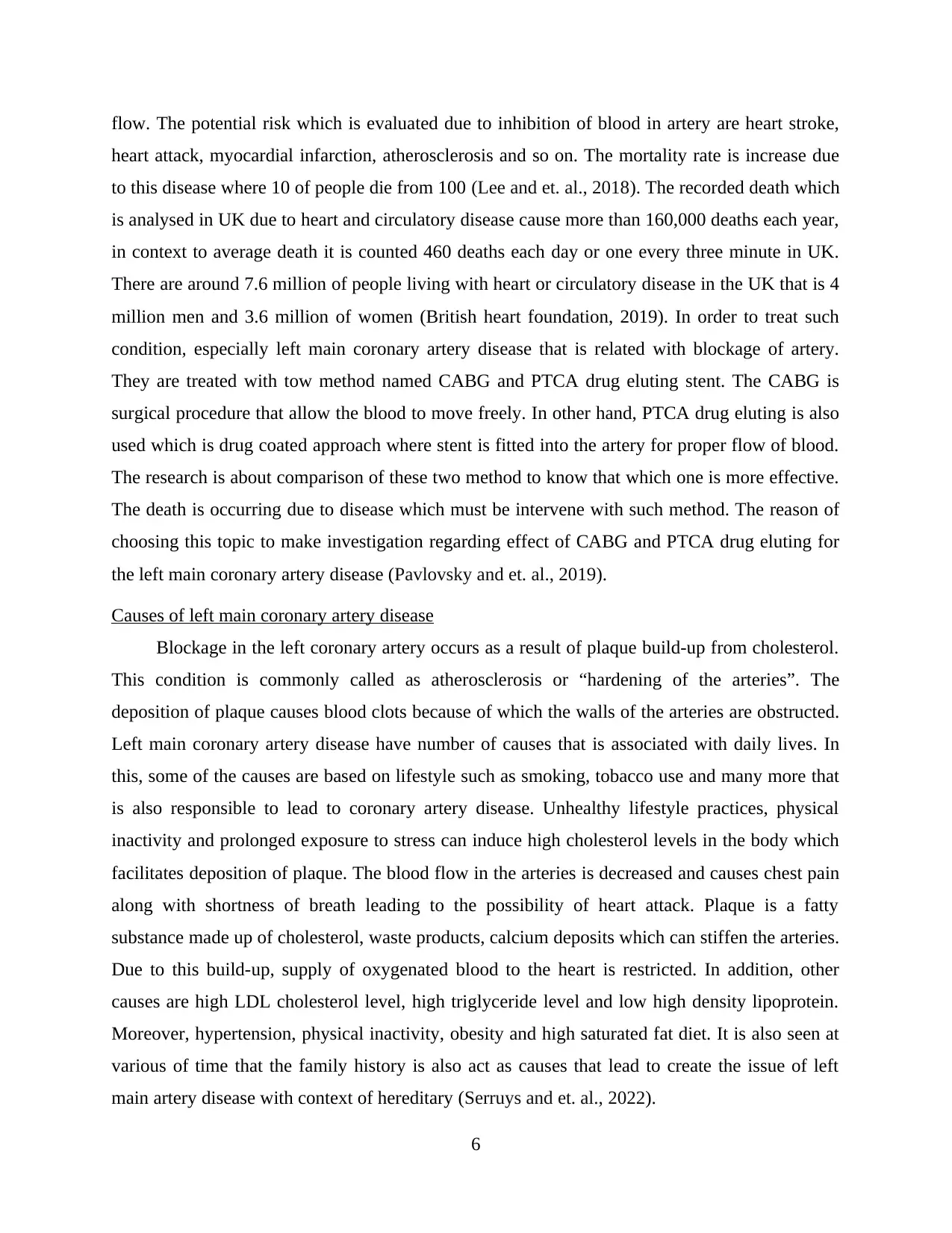
flow. The potential risk which is evaluated due to inhibition of blood in artery are heart stroke,
heart attack, myocardial infarction, atherosclerosis and so on. The mortality rate is increase due
to this disease where 10 of people die from 100 (Lee and et. al., 2018). The recorded death which
is analysed in UK due to heart and circulatory disease cause more than 160,000 deaths each year,
in context to average death it is counted 460 deaths each day or one every three minute in UK.
There are around 7.6 million of people living with heart or circulatory disease in the UK that is 4
million men and 3.6 million of women (British heart foundation, 2019). In order to treat such
condition, especially left main coronary artery disease that is related with blockage of artery.
They are treated with tow method named CABG and PTCA drug eluting stent. The CABG is
surgical procedure that allow the blood to move freely. In other hand, PTCA drug eluting is also
used which is drug coated approach where stent is fitted into the artery for proper flow of blood.
The research is about comparison of these two method to know that which one is more effective.
The death is occurring due to disease which must be intervene with such method. The reason of
choosing this topic to make investigation regarding effect of CABG and PTCA drug eluting for
the left main coronary artery disease (Pavlovsky and et. al., 2019).
Causes of left main coronary artery disease
Blockage in the left coronary artery occurs as a result of plaque build-up from cholesterol.
This condition is commonly called as atherosclerosis or “hardening of the arteries”. The
deposition of plaque causes blood clots because of which the walls of the arteries are obstructed.
Left main coronary artery disease have number of causes that is associated with daily lives. In
this, some of the causes are based on lifestyle such as smoking, tobacco use and many more that
is also responsible to lead to coronary artery disease. Unhealthy lifestyle practices, physical
inactivity and prolonged exposure to stress can induce high cholesterol levels in the body which
facilitates deposition of plaque. The blood flow in the arteries is decreased and causes chest pain
along with shortness of breath leading to the possibility of heart attack. Plaque is a fatty
substance made up of cholesterol, waste products, calcium deposits which can stiffen the arteries.
Due to this build-up, supply of oxygenated blood to the heart is restricted. In addition, other
causes are high LDL cholesterol level, high triglyceride level and low high density lipoprotein.
Moreover, hypertension, physical inactivity, obesity and high saturated fat diet. It is also seen at
various of time that the family history is also act as causes that lead to create the issue of left
main artery disease with context of hereditary (Serruys and et. al., 2022).
6
heart attack, myocardial infarction, atherosclerosis and so on. The mortality rate is increase due
to this disease where 10 of people die from 100 (Lee and et. al., 2018). The recorded death which
is analysed in UK due to heart and circulatory disease cause more than 160,000 deaths each year,
in context to average death it is counted 460 deaths each day or one every three minute in UK.
There are around 7.6 million of people living with heart or circulatory disease in the UK that is 4
million men and 3.6 million of women (British heart foundation, 2019). In order to treat such
condition, especially left main coronary artery disease that is related with blockage of artery.
They are treated with tow method named CABG and PTCA drug eluting stent. The CABG is
surgical procedure that allow the blood to move freely. In other hand, PTCA drug eluting is also
used which is drug coated approach where stent is fitted into the artery for proper flow of blood.
The research is about comparison of these two method to know that which one is more effective.
The death is occurring due to disease which must be intervene with such method. The reason of
choosing this topic to make investigation regarding effect of CABG and PTCA drug eluting for
the left main coronary artery disease (Pavlovsky and et. al., 2019).
Causes of left main coronary artery disease
Blockage in the left coronary artery occurs as a result of plaque build-up from cholesterol.
This condition is commonly called as atherosclerosis or “hardening of the arteries”. The
deposition of plaque causes blood clots because of which the walls of the arteries are obstructed.
Left main coronary artery disease have number of causes that is associated with daily lives. In
this, some of the causes are based on lifestyle such as smoking, tobacco use and many more that
is also responsible to lead to coronary artery disease. Unhealthy lifestyle practices, physical
inactivity and prolonged exposure to stress can induce high cholesterol levels in the body which
facilitates deposition of plaque. The blood flow in the arteries is decreased and causes chest pain
along with shortness of breath leading to the possibility of heart attack. Plaque is a fatty
substance made up of cholesterol, waste products, calcium deposits which can stiffen the arteries.
Due to this build-up, supply of oxygenated blood to the heart is restricted. In addition, other
causes are high LDL cholesterol level, high triglyceride level and low high density lipoprotein.
Moreover, hypertension, physical inactivity, obesity and high saturated fat diet. It is also seen at
various of time that the family history is also act as causes that lead to create the issue of left
main artery disease with context of hereditary (Serruys and et. al., 2022).
6
⊘ This is a preview!⊘
Do you want full access?
Subscribe today to unlock all pages.

Trusted by 1+ million students worldwide
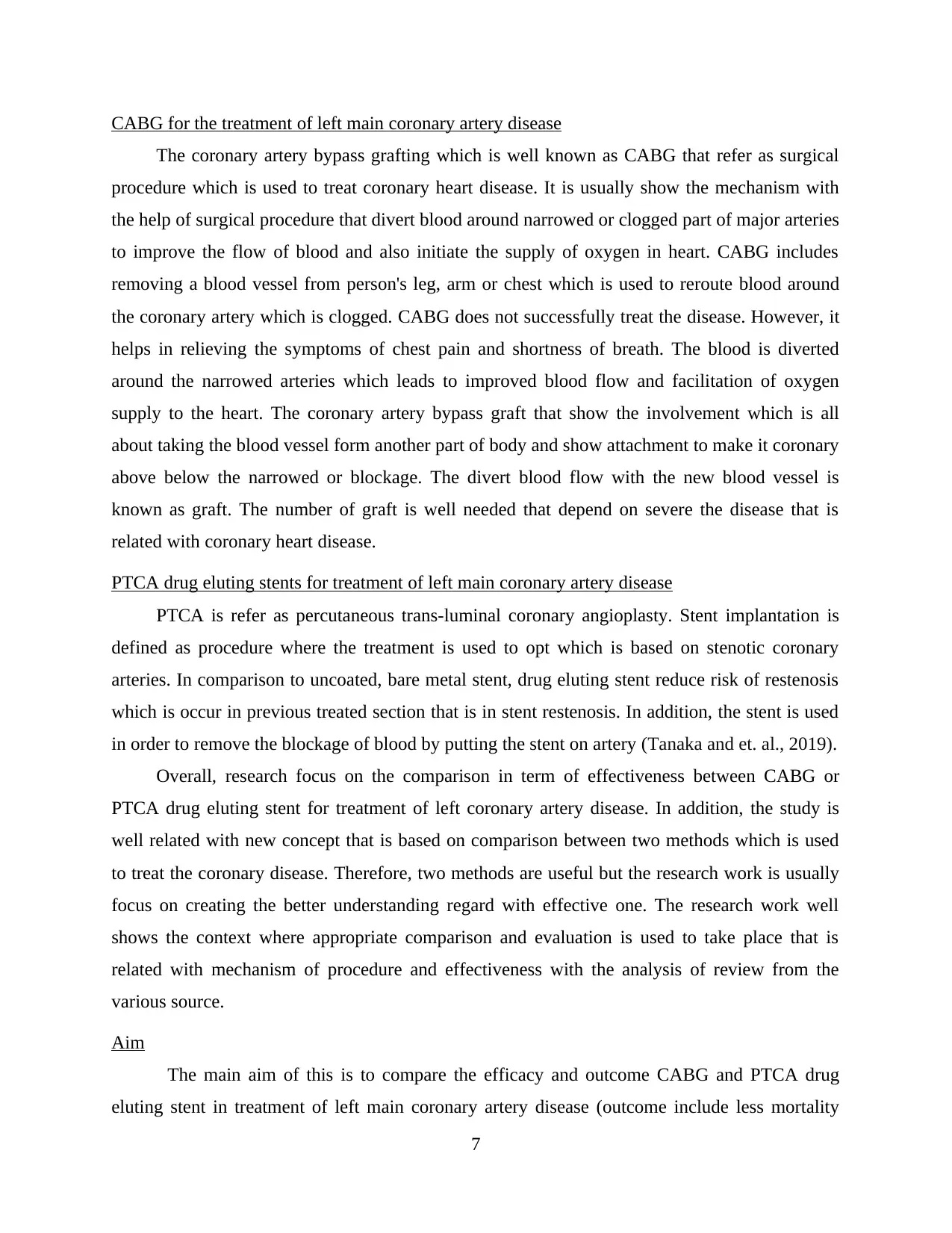
CABG for the treatment of left main coronary artery disease
The coronary artery bypass grafting which is well known as CABG that refer as surgical
procedure which is used to treat coronary heart disease. It is usually show the mechanism with
the help of surgical procedure that divert blood around narrowed or clogged part of major arteries
to improve the flow of blood and also initiate the supply of oxygen in heart. CABG includes
removing a blood vessel from person's leg, arm or chest which is used to reroute blood around
the coronary artery which is clogged. CABG does not successfully treat the disease. However, it
helps in relieving the symptoms of chest pain and shortness of breath. The blood is diverted
around the narrowed arteries which leads to improved blood flow and facilitation of oxygen
supply to the heart. The coronary artery bypass graft that show the involvement which is all
about taking the blood vessel form another part of body and show attachment to make it coronary
above below the narrowed or blockage. The divert blood flow with the new blood vessel is
known as graft. The number of graft is well needed that depend on severe the disease that is
related with coronary heart disease.
PTCA drug eluting stents for treatment of left main coronary artery disease
PTCA is refer as percutaneous trans-luminal coronary angioplasty. Stent implantation is
defined as procedure where the treatment is used to opt which is based on stenotic coronary
arteries. In comparison to uncoated, bare metal stent, drug eluting stent reduce risk of restenosis
which is occur in previous treated section that is in stent restenosis. In addition, the stent is used
in order to remove the blockage of blood by putting the stent on artery (Tanaka and et. al., 2019).
Overall, research focus on the comparison in term of effectiveness between CABG or
PTCA drug eluting stent for treatment of left coronary artery disease. In addition, the study is
well related with new concept that is based on comparison between two methods which is used
to treat the coronary disease. Therefore, two methods are useful but the research work is usually
focus on creating the better understanding regard with effective one. The research work well
shows the context where appropriate comparison and evaluation is used to take place that is
related with mechanism of procedure and effectiveness with the analysis of review from the
various source.
Aim
The main aim of this is to compare the efficacy and outcome CABG and PTCA drug
eluting stent in treatment of left main coronary artery disease (outcome include less mortality
7
The coronary artery bypass grafting which is well known as CABG that refer as surgical
procedure which is used to treat coronary heart disease. It is usually show the mechanism with
the help of surgical procedure that divert blood around narrowed or clogged part of major arteries
to improve the flow of blood and also initiate the supply of oxygen in heart. CABG includes
removing a blood vessel from person's leg, arm or chest which is used to reroute blood around
the coronary artery which is clogged. CABG does not successfully treat the disease. However, it
helps in relieving the symptoms of chest pain and shortness of breath. The blood is diverted
around the narrowed arteries which leads to improved blood flow and facilitation of oxygen
supply to the heart. The coronary artery bypass graft that show the involvement which is all
about taking the blood vessel form another part of body and show attachment to make it coronary
above below the narrowed or blockage. The divert blood flow with the new blood vessel is
known as graft. The number of graft is well needed that depend on severe the disease that is
related with coronary heart disease.
PTCA drug eluting stents for treatment of left main coronary artery disease
PTCA is refer as percutaneous trans-luminal coronary angioplasty. Stent implantation is
defined as procedure where the treatment is used to opt which is based on stenotic coronary
arteries. In comparison to uncoated, bare metal stent, drug eluting stent reduce risk of restenosis
which is occur in previous treated section that is in stent restenosis. In addition, the stent is used
in order to remove the blockage of blood by putting the stent on artery (Tanaka and et. al., 2019).
Overall, research focus on the comparison in term of effectiveness between CABG or
PTCA drug eluting stent for treatment of left coronary artery disease. In addition, the study is
well related with new concept that is based on comparison between two methods which is used
to treat the coronary disease. Therefore, two methods are useful but the research work is usually
focus on creating the better understanding regard with effective one. The research work well
shows the context where appropriate comparison and evaluation is used to take place that is
related with mechanism of procedure and effectiveness with the analysis of review from the
various source.
Aim
The main aim of this is to compare the efficacy and outcome CABG and PTCA drug
eluting stent in treatment of left main coronary artery disease (outcome include less mortality
7
Paraphrase This Document
Need a fresh take? Get an instant paraphrase of this document with our AI Paraphraser
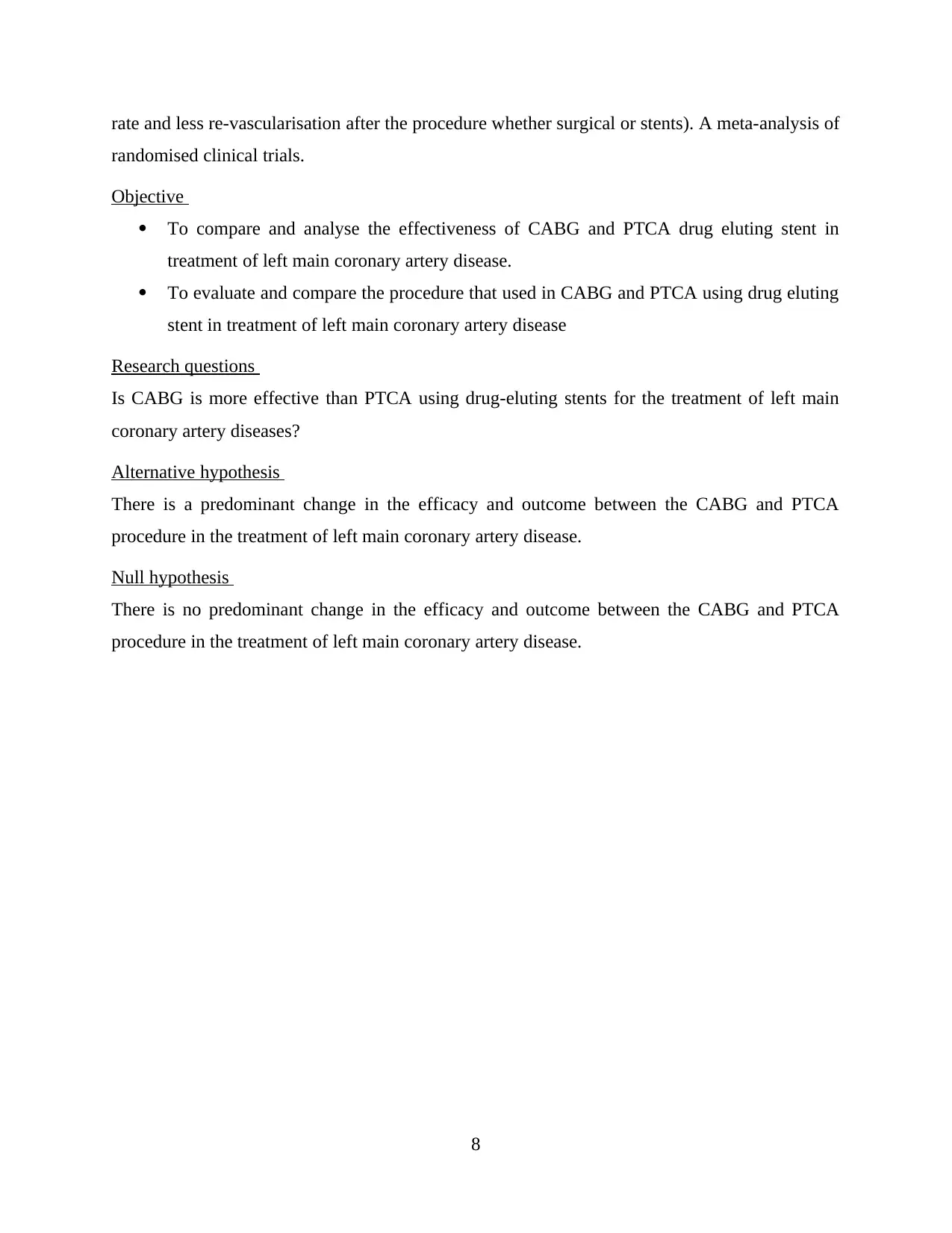
rate and less re-vascularisation after the procedure whether surgical or stents). A meta-analysis of
randomised clinical trials.
Objective
To compare and analyse the effectiveness of CABG and PTCA drug eluting stent in
treatment of left main coronary artery disease.
To evaluate and compare the procedure that used in CABG and PTCA using drug eluting
stent in treatment of left main coronary artery disease
Research questions
Is CABG is more effective than PTCA using drug-eluting stents for the treatment of left main
coronary artery diseases?
Alternative hypothesis
There is a predominant change in the efficacy and outcome between the CABG and PTCA
procedure in the treatment of left main coronary artery disease.
Null hypothesis
There is no predominant change in the efficacy and outcome between the CABG and PTCA
procedure in the treatment of left main coronary artery disease.
8
randomised clinical trials.
Objective
To compare and analyse the effectiveness of CABG and PTCA drug eluting stent in
treatment of left main coronary artery disease.
To evaluate and compare the procedure that used in CABG and PTCA using drug eluting
stent in treatment of left main coronary artery disease
Research questions
Is CABG is more effective than PTCA using drug-eluting stents for the treatment of left main
coronary artery diseases?
Alternative hypothesis
There is a predominant change in the efficacy and outcome between the CABG and PTCA
procedure in the treatment of left main coronary artery disease.
Null hypothesis
There is no predominant change in the efficacy and outcome between the CABG and PTCA
procedure in the treatment of left main coronary artery disease.
8
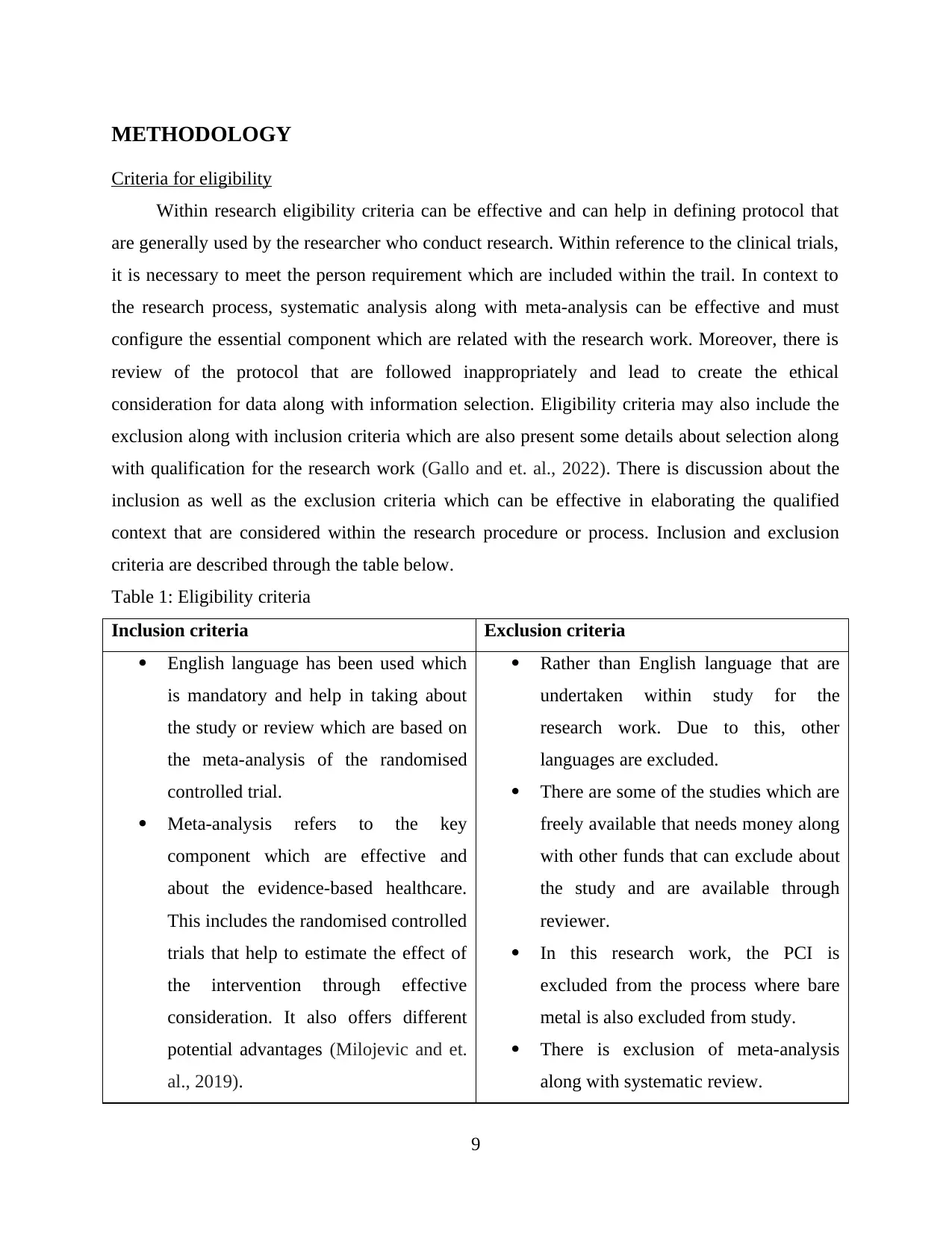
METHODOLOGY
Criteria for eligibility
Within research eligibility criteria can be effective and can help in defining protocol that
are generally used by the researcher who conduct research. Within reference to the clinical trials,
it is necessary to meet the person requirement which are included within the trail. In context to
the research process, systematic analysis along with meta-analysis can be effective and must
configure the essential component which are related with the research work. Moreover, there is
review of the protocol that are followed inappropriately and lead to create the ethical
consideration for data along with information selection. Eligibility criteria may also include the
exclusion along with inclusion criteria which are also present some details about selection along
with qualification for the research work (Gallo and et. al., 2022). There is discussion about the
inclusion as well as the exclusion criteria which can be effective in elaborating the qualified
context that are considered within the research procedure or process. Inclusion and exclusion
criteria are described through the table below.
Table 1: Eligibility criteria
Inclusion criteria Exclusion criteria
English language has been used which
is mandatory and help in taking about
the study or review which are based on
the meta-analysis of the randomised
controlled trial.
Meta-analysis refers to the key
component which are effective and
about the evidence-based healthcare.
This includes the randomised controlled
trials that help to estimate the effect of
the intervention through effective
consideration. It also offers different
potential advantages (Milojevic and et.
al., 2019).
Rather than English language that are
undertaken within study for the
research work. Due to this, other
languages are excluded.
There are some of the studies which are
freely available that needs money along
with other funds that can exclude about
the study and are available through
reviewer.
In this research work, the PCI is
excluded from the process where bare
metal is also excluded from study.
There is exclusion of meta-analysis
along with systematic review.
9
Criteria for eligibility
Within research eligibility criteria can be effective and can help in defining protocol that
are generally used by the researcher who conduct research. Within reference to the clinical trials,
it is necessary to meet the person requirement which are included within the trail. In context to
the research process, systematic analysis along with meta-analysis can be effective and must
configure the essential component which are related with the research work. Moreover, there is
review of the protocol that are followed inappropriately and lead to create the ethical
consideration for data along with information selection. Eligibility criteria may also include the
exclusion along with inclusion criteria which are also present some details about selection along
with qualification for the research work (Gallo and et. al., 2022). There is discussion about the
inclusion as well as the exclusion criteria which can be effective in elaborating the qualified
context that are considered within the research procedure or process. Inclusion and exclusion
criteria are described through the table below.
Table 1: Eligibility criteria
Inclusion criteria Exclusion criteria
English language has been used which
is mandatory and help in taking about
the study or review which are based on
the meta-analysis of the randomised
controlled trial.
Meta-analysis refers to the key
component which are effective and
about the evidence-based healthcare.
This includes the randomised controlled
trials that help to estimate the effect of
the intervention through effective
consideration. It also offers different
potential advantages (Milojevic and et.
al., 2019).
Rather than English language that are
undertaken within study for the
research work. Due to this, other
languages are excluded.
There are some of the studies which are
freely available that needs money along
with other funds that can exclude about
the study and are available through
reviewer.
In this research work, the PCI is
excluded from the process where bare
metal is also excluded from study.
There is exclusion of meta-analysis
along with systematic review.
9
⊘ This is a preview!⊘
Do you want full access?
Subscribe today to unlock all pages.

Trusted by 1+ million students worldwide
1 out of 45
Your All-in-One AI-Powered Toolkit for Academic Success.
+13062052269
info@desklib.com
Available 24*7 on WhatsApp / Email
![[object Object]](/_next/static/media/star-bottom.7253800d.svg)
Unlock your academic potential
Copyright © 2020–2026 A2Z Services. All Rights Reserved. Developed and managed by ZUCOL.

